Method detection limits (MDLs) have been characterized for the recently regulated HON (hazardous organic NESHAP [National Emission Standards for Hazardous Air Pollutants]) compounds, which corroborate selected ion flow tube mass spectrometry (SIFT-MS) as an efficient method for gauging various environmental pollutants, including toxic volatile organic compounds (VOCs), in ambient environments at the fence line or in a mobile environment.
SIFT-MS provides exceptional sensitivity, speed, and ease of use in environmental observation applications.

Image Credit: petrmalinak/Shutterstock.com
Introduction
HON facilities are factories that manufacture chemicals that present a significant cancer risk to local communities. There are over 200 of these factories in the US.
In early 2024, the Environmental Protection Agency (EPA) in the US distributed regulations dictating the fenceline observation of six harmful VOCs produced in these factories: chloroprene, ethylene oxide (EtO), 1,3-butadiene, benzene, ethylene dichloride, and vinyl chloride.
These new regulations specify action levels for these composites as thresholds for annual average air concentrations. If these levels are surpassed at the fenceline, the source of pollution must be identified and resolved to control these hazardous emissions efficiently.
SIFT-MS supports the direct, real-time observation of VOCs and inorganic composites in the environment and has been used globally by governments and businesses for environmental observation. South Korean government organizations have used SIFT-MS for years for the observation of dangerous VOCs at the federal and state levels.1
The US EPA recently approved SIFT-MS for mobile laboratories and real-time portable observation systems.
Syft Technologies advanced comprehensive sampling methodologies for harmful VOCs to respond to the new HON regulations. Such approaches have yielded MDLs in the low- to mid-part per trillion by volume (pptV) range, showing that SIFT-MS is an efficient solution for observing these and other chemicals in ambient environments.
Real-time observation with SIFT-MS can link emissions to specific events, allowing users to better understand plant operations while still meeting regulations.
Method
SIFT-MS realizes real-time specificity by linking rapidly switchable reagent ions with diverse reaction processes that can recognize numerous chemicals in a single study.
Paired with library records of ion-molecule reaction rate constants, MS detection accurately measures target substances.
This study employs a SIFT-MS apparatus, the Syft Tracer, driven by nitrogen carrier gas and fortified with a high-performance inlet (HPI). This apparatus permits the direct analysis of samples, minimizing volatile loss.
Samples were prepared by diluting reference standards in humid, clean air to achieve a constant flow at the concentration of interest (40-50 % relative humidity). The samples were transferred to the HPI using a flow post setup.
Library entries were used to create one-minute techniques for each composite. The approaches comprised quick reactions for reactive composites with multiple reagent ions.
The measurement time for procedures involving positive reagent ions (H3O+, NO+, and O2+) and negative reagent ions (O-, OH-, O2-, NO2-, and NO3-) was two minutes, divided into one minute for each phase.
MDLs were determined using the EPA technique EPA 821-R-16-006.2 The presence of the isomer acetaldehyde influences the quantification of EtO in H3O+.3
The method tested includes withdrawing acetaldehyde as it reacts with NO+. The EtO MDL was assessed with 2.5 ppbV acetaldehyde, ensuring the results showed an accurate environmental sample.
Table 1. Action levels for HON compounds. Source: Syft Technologies
| Analyte |
Molecular Formula |
HON Action Level |
| (μg/m3) |
(pptV) |
| Benzene |
C6H6 |
9 |
2770 |
| 1,3-Butadiene |
C4H6 |
3 |
1335 |
| Choloroprene |
C4H5Cl |
0.8 |
217 |
| Ethylene oxide |
C2H4O |
0.2 |
109 |
| Vinyl chloride |
C2H3Cl |
3 |
1155 |
| Ethylene dichloride |
C2H4Cl2 |
4 |
990 |
*μg/m³ to pptV conversion at 20 °C.
Results
MDLs were analyzed for additional environmentally important materials in addition to HON chemicals. Tables 2 and 3 show the MDLs for each molecule that can be achieved in one minute using the SIFT-MS.
Table 2. Comparison of MDLs using SIFT-MS with HON compound action levels. Results are for one-minute methods using a single reagent ion, except for EtO. Source: Syft Technologies
| Compound |
MDL (pptV) |
HON Action Level (pptV) |
| Vinyl chloride |
460 |
1170 |
| 1,3-Butadiene |
60 |
1360 |
| Benzene |
50 |
2820 |
| Ethylene oxide |
105† |
110 |
| Ethylene dichloride |
260 |
990 |
†EtO MDL over 30 minutes in the presence of 2.5 ppbV acetaldehyde (see Discussion).
Table 3. MDLs for environmentally important compounds using SIFT-MS. Results are for one-minute methods using a single reagent ion. Source: Syft Technologies
| Compound |
MDL (pptV) |
| Toluene |
25 |
| Xylenes and ethylbenzene |
55 |
| Hydrogen sulfide |
125 |
| Trichloroethylene |
165 |
| Nitrogen dioxide |
65 |
| Sulfur dioxide |
200 |
| Trans-1,2-dichloroethylene |
100 |
| 1,3,5-trimethylbenzene |
65 |
| Ammonia |
595 |
| Acetaldehyde |
35 |
| Formaldehyde |
595 |
| Methyl bromide |
90 |
| n-butane |
250 |
| Acrolein |
120 |
Discussion
Tables 2 and 3 show MLDs of the capabilities of single-composite SIFT-MS methods carried out over one minute (30 minutes for EtO). All HON chemicals have MDLs lower than the EPA’s action limit (AL) for fenceline observation.
The new EPA requirements for HON compound fenceline observation necessitate alternate observational methodologies to obtain MDLs at least 1/3 of the AL for the monitored composites.
Lengthening the observation time allows for easy attainment of lower MDLs for any SIFT-MS approach. The improvement in MDL is approximately proportional to the inverse square root of the method length.
EtO gives an excellent demonstration of how altering method duration can drastically improve an MDL.
A large dataset of genuine EtO one-minute scan data was combined over time, permitting MDLs to be calculated for the aggregated datasets. For EtO, the MDL using a one-minute technique surpassed the HON AL. Figure 1 shows the improvement in EtO MDL attained by increasing the procedure duration.
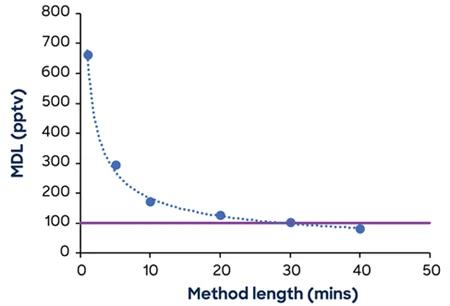
Figure 1. EtO MDL in the presence of 2.5 ppbV acetaldehyde as a function of method length. The horizontal line marks the HON action level. Image Credit: Syft Technologies
The MDL for EtO falls under the HON AL when the technique exceeds 30 minutes. To reach an MDL of 1/3 of the AL, the procedure would need to be increased to around three hours.
This time frame is considerably shorter than the 24-hour average concentration controlled by the traditional canister method for EtO, allowing many high-precision samples to be taken within the necessary 24-hour timeframe.
SIFT-MS has substantially improved temporal resolution for all HON chemicals compared to the EPA-specified methods (canister and passive sampling), permitting improved source identification in the case of a concentration above the AL.
In correspondence with the EPA protocol, MDLs can be determined by reviewing the calibration region with a considerable change in sensitivity, such as a break in the calibration’s slope.
To verify the MDLs shown in tables 2 and 3, measured at a single concentration, low-concentration calibrations were carried out for each chemical down to low pptV values. Figure 2 shows an example of 1,3-butadiene.
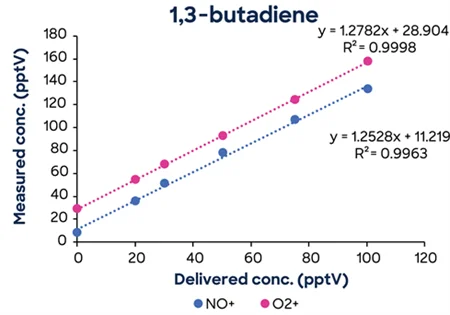
Figure 2. 1,3-Butadiene low concentration calibration showing excellent linearity down to low pptV concentrations. Image Credit: Syft Technologies
Concentrations of O2⁺ and NO⁺ show outstanding linearity down to less than 20 pptV. This high association demonstrates that the 1,3-butadiene MDL shown in Table 2 is rational and achievable.
Figure 3 shows additional low-concentration calibrations demonstrating SIFT-MS linearity down to low pptV values.
The measurement of the MDL of chloroprene was recently completed and recorded as 145 pptV under the HON AL of 220 pptV. The lower AL of 83 pptV is applied to facilities collocated with neoprene production sources.
Like the EtO approach, the chloroprene MDL can be lowered to beneath this AL by extending the procedure length to five minutes.
Syft Tracer’s flexibility and aptitude to quickly examine multiple chemical species at low pptV concentrations make it an exceptional choice for observing the trace quantities of dangerous environmental contaminants. SIFT-MS is easily automated, offers a simple data stream, and can operate without observation.
It is the ideal solution for industry stakeholders aiming to go beyond basic compliance and attain a higher standard of operational excellence.
SIFT-MS is well-positioned to speak to future regulatory issues due to its widespread database of ion-molecule reactions, including environmentally pertinent chemicals.
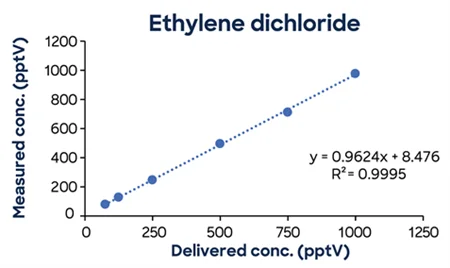
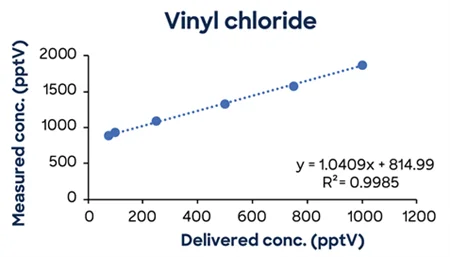
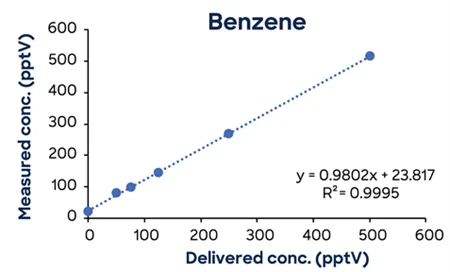
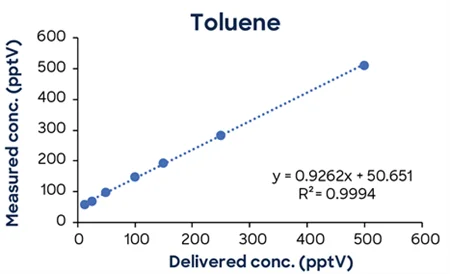
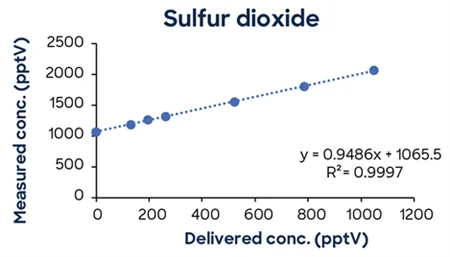
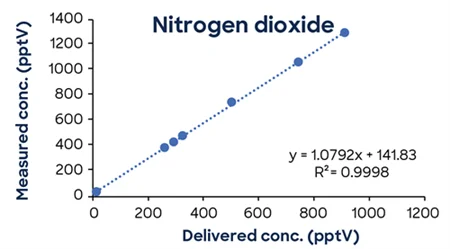
Figure 3. Low-concentration calibrations using simple one-minute methods exhibit excellent linearity down to low ppt concentrations. Image Credit: Syft Technologies
Conclusions
SIFT-MS measurements offer significant benefits over customary techniques with long sample collection times and external laboratory analysis.
Unlike such methods, which can administer short-term variations in pollutant concentrations, SIFT-MS provides fast, continuous data, supporting the early detection of toxic substances.
This feature expands the precision of source identification and permits quicker reactions to possible environmental concerns, leading to more efficient observation and public health protection.
SIFT-MS Mechanisms
SIFT-MS uses soft chemical ionization to create mass-selected reagent ions capable of rapidly reacting with and quantifying VOCs down to pptV.
Industrial SIFT-MS equipment now utilizes up to eight reagent ions (H3O+, NO+, O2+, O-, OH-, O2-, NO2-, and NO3-) derived from a microwave discharge in the air.
These ions react with VOCs and other trace analytes in well-controlled ion-molecule reactions but not with the primary components of the air (N2, O2, and Ar).
This allows for the real-time and direct examination of environmental samples at trace and ultra-trace levels, with no pre-concentration required. Rapid switching between reagent ions offers great selectivity because the numerous reaction processes allow for independent measurements of each analyte.
Multiple reagent ions frequently decrease ambiguity from isobaric overlaps in mixtures with multiple analytes. The library entry’s reaction rate constant (k) is employed to compute composite concentrations.4
References and Further Reading
- Langford, V. S., et al. (2023a). Adoption of SIFT-MS for VOC Pollution Monitoring in South Korea. Environments, 10(12), pp.201–201. https://doi.org/10.3390/environments10120201
- EPA (2016). EPA 821-R-16-006 - Definition and Procedure for the Determination of the Method Detection Limit, Revision 2.
- Swift, S. J, et al. (2023). Accurate selected ion flow tube mass spectrometry quantification of ethylene oxide contamination in the presence of acetaldehyde. Analytical Methods, 15(46), pp.6435–6443. https://doi.org/10.1039/D3AY01036H
- Langford, V.S., Kseniya Dryahina and Patrik Španěl (2023). Robust Automated SIFT-MS Quantitation of Volatile Compounds in Air Using a Multicomponent Gas Standard. Journal of the American Society for Mass Spectrometry, 34(12), pp.2630–2645. https://doi.org/10.1021/jasms.3c00312

This information has been sourced, reviewed and adapted from materials provided by Syft Technologies.
For more information on this source, please visit Syft Technologies.